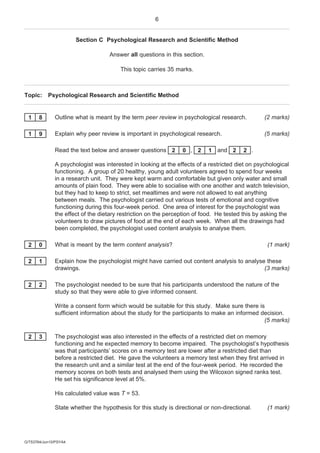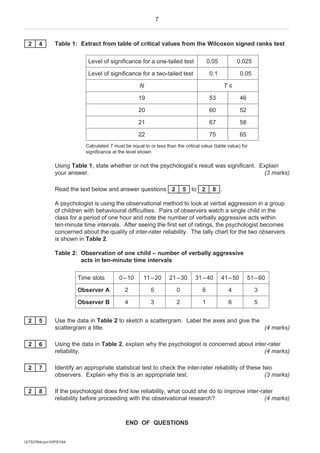PSYA4 June 2010
- 1. General Certificate of Education Advanced Level Examination June 2010 Psychology (Specification A) PSYA4 Unit 4 Psychopathology, Psychology in Action and Research Methods Wednesday 30 June 2010 1.30 pm to 3.30 pm For this paper you must have: a 16-page answer book. Time allowed 2 hours Instructions Use black ink or black ball-point pen. Write the information required on the front of your answer book. The Examining Body for this paper is AQA. The Paper Reference is PSYA4. In Section A, choose one topic. Answer all questions on the topic you choose. Where appropriate, refer to theories and/or studies. In Section B, choose one topic. Answer all questions on the topic you choose. Where appropriate, refer to theories and/or studies, approaches, issues and debates. In Section C, you should answer all questions. Do all rough work in the answer book. Cross through any work you do not want to be marked. Information The marks for questions are shown in brackets. The maximum mark for this paper is 85. In Section A and in Section B, you will be marked on your ability to: – use good English – organise information clearly – use specialist vocabulary where appropriate. G/T53764/Jun10/PSYA4 6/6/6/6/ PSYA4
- 2. 2 There are no questions printed on this page G/T53764/Jun10/PSYA4
- 3. 3 Section A Psychopathology Choose one topic from Section A. Answer all questions on the topic you choose. Each topic carries 25 marks. Where appropriate, refer to theories and/or studies. Topic: Schizophrenia 0 1 ‘In an important and influential criticism of the diagnosis of mental illness, Rosenhan (1973) showed that healthy ‘pseudopatients’ could gain admission to psychiatric hospital by pretending to have auditory hallucinations. Although systems of classification and diagnosis have changed considerably since the 1970s, many people still have concerns about their accuracy and appropriateness.’ Discuss issues surrounding the classification and diagnosis of schizophrenia. (9 marks + 16 marks) Topic: Depression 0 2 Outline at least one biological explanation of depression and at least one psychological explanation of depression. (9 marks) 0 3 Evaluate biological and psychological explanations of depression. (16 marks) Topic: Anxiety Disorders 0 4 Outline clinical characteristics of one anxiety disorder. (4 marks) 0 5 Briefly describe one psychological therapy for the anxiety disorder that you outlined in your answer to 0 4 . (5 marks) 0 6 Evaluate psychological therapies for this anxiety disorder. (16 marks) Turn over for the next section Turn over G/T53764/Jun10/PSYA4
- 4. 4 Section B Psychology in Action Choose one topic from Section B. Answer all questions on the topic you choose. Each topic carries 25 marks. Where appropriate, refer to theories and/or studies, approaches, issues and debates. Topic: Media Psychology 0 7 ‘It has been suggested that people who watch violent media images may be encouraged to imitate the violence. Television and film producers frequently reject this view.’ Discuss what psychological research has told us about some of the media influences on anti-social behaviour. (5 marks + 6 marks) 0 8 A group of students has been asked to produce a short film to encourage more school leavers to apply for science degree courses at university instead of arts-based courses. Using your knowledge of psychological research into persuasion and attitude change, identify some of the factors which the film-makers might take into account. (4 marks) 0 9 Explain how factors such as those you identified in your answer to 0 8 might help to persuade young people to apply for particular courses. (10 marks) Topic: The Psychology of Addictive Behaviour 1 0 ‘Sally is a young woman who puts herself down all the time. She thinks that she is overweight and has started to diet. Like her parents and some of her friends, Sally smokes cigarettes. Her smoking habit has recently become excessive and she is now addicted to nicotine.’ Using your knowledge of the psychology of addictive behaviour, explain some of the likely reasons why Sally has become addicted to smoking. (6 marks) 1 1 Outline the theory of reasoned action. (5 marks) 1 2 Outline two examples of public health interventions aimed at reducing addictive behaviour. (4 marks) 1 3 Assess the effectiveness of public health interventions and/or legislation in reducing addictive behaviour. (10 marks) G/T53764/Jun10/PSYA4
- 5. 5 Topic: Anomalistic Psychology 1 4 Explain what is meant by pseudoscience. (5 marks) 1 5 During a public demonstration of ‘psychic powers’, a psychologist witnessed what appeared to be the ability of one person to read the thoughts of another. Explain how the psychologist could use the Ganzfeld procedure to investigate this apparent ability. (6 marks) 1 6 At the same event, the psychologist observed that many audience members appeared impressed by, and expressed a belief in, the abilities of a psychic medium. Outline two or more factors underlying belief in anomalous experience. (4 marks) 1 7 Consider how such factors can be used to understand belief in psychic mediumship. (10 marks) Turn over for the next section Turn over G/T53764/Jun10/PSYA4
- 6. 6 Section C Psychological Research and Scientific Method Answer all questions in this section. This topic carries 35 marks. Topic: Psychological Research and Scientific Method 1 8 Outline what is meant by the term peer review in psychological research. (2 marks) 1 9 Explain why peer review is important in psychological research. (5 marks) Read the text below and answer questions 2 0 , 2 1 and 2 2 . A psychologist was interested in looking at the effects of a restricted diet on psychological functioning. A group of 20 healthy, young adult volunteers agreed to spend four weeks in a research unit. They were kept warm and comfortable but given only water and small amounts of plain food. They were able to socialise with one another and watch television, but they had to keep to strict, set mealtimes and were not allowed to eat anything between meals. The psychologist carried out various tests of emotional and cognitive functioning during this four-week period. One area of interest for the psychologist was the effect of the dietary restriction on the perception of food. He tested this by asking the volunteers to draw pictures of food at the end of each week. When all the drawings had been completed, the psychologist used content analysis to analyse them. 2 0 What is meant by the term content analysis? (1 mark) 2 1 Explain how the psychologist might have carried out content analysis to analyse these drawings. (3 marks) 2 2 The psychologist needed to be sure that his participants understood the nature of the study so that they were able to give informed consent. Write a consent form which would be suitable for this study. Make sure there is sufficient information about the study for the participants to make an informed decision. (5 marks) 2 3 The psychologist was also interested in the effects of a restricted diet on memory functioning and he expected memory to become impaired. The psychologist’s hypothesis was that participants’ scores on a memory test are lower after a restricted diet than before a restricted diet. He gave the volunteers a memory test when they first arrived in the research unit and a similar test at the end of the four-week period. He recorded the memory scores on both tests and analysed them using the Wilcoxon signed ranks test. He set his significance level at 5%. His calculated value was T = 53. State whether the hypothesis for this study is directional or non-directional. (1 mark) G/T53764/Jun10/PSYA4
- 7. 7 2 4 Table 1: Extract from table of critical values from the Wilcoxon signed ranks test Level of significance for a one-tailed test 0.05 0.025 Level of significance for a two-tailed test 0.1 0.05 N T≤ 19 53 46 20 60 52 21 67 58 22 75 65 Calculated T must be equal to or less than the critical value (table value) for significance at the level shown Using Table 1, state whether or not the psychologist’s result was significant. Explain your answer. (3 marks) Read the text below and answer questions 2 5 to 2 8 . A psychologist is using the observational method to look at verbal aggression in a group of children with behavioural difficulties. Pairs of observers watch a single child in the class for a period of one hour and note the number of verbally aggressive acts within ten-minute time intervals. After seeing the first set of ratings, the psychologist becomes concerned about the quality of inter-rater reliability. The tally chart for the two observers is shown in Table 2. Table 2: Observation of one child – number of verbally aggressive acts in ten-minute time intervals Time slots 0 – 10 11 – 20 21 – 30 31 – 40 41 – 50 51 – 60 Observer A 2 5 0 6 4 3 Observer B 4 3 2 1 6 5 2 5 Use the data in Table 2 to sketch a scattergram. Label the axes and give the scattergram a title. (4 marks) 2 6 Using the data in Table 2, explain why the psychologist is concerned about inter-rater reliability. (4 marks) 2 7 Identify an appropriate statistical test to check the inter-rater reliability of these two observers. Explain why this is an appropriate test. (3 marks) 2 8 If the psychologist does find low reliability, what could she do to improve inter-rater reliability before proceeding with the observational research? (4 marks) END OF QUESTIONS G/T53764/Jun10/PSYA4
- 8. 8 There are no questions printed on this page Copyright © 2010 AQA and its licensors. All rights reserved. G/T53764/Jun10/PSYA4







